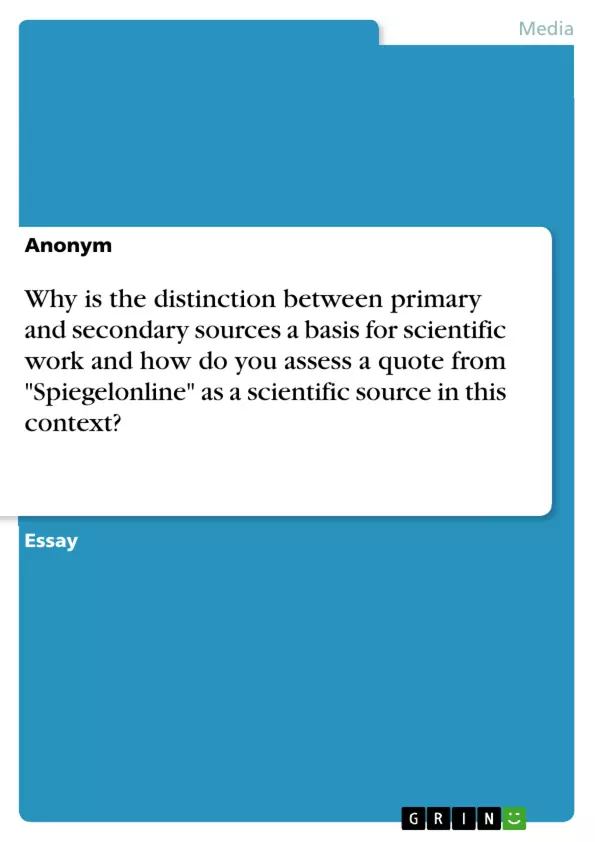This essay deals with the question of why the distinction between primary and secondary sources is a basis for scientific work and how a quote from “Spiegelonline” is assessed as a scientific source in this context. In the course of this paper various reasons for a distinction between the source types will be depicted as well as why quoting from secondary sources entails problems. Also how those issues could pose as a serious danger to the quality of scientific work in general will be addressed. A scientific ethical point of view will be especially looked at in the main part of why a distinction between primary and secondary sources makes sense.
Inhaltsverzeichnis (Table of Contents)
- Abstract
- 1. Introduction
- 2. Theoretical foundation
- 3. Distinction between primary and secondary sources as a basis for scientific work
- 3.1. A scientific ethical point of view
- 3.2. Further reasons for the distinction between primary and secondary sources
- 3.3. Assessment of a quote from “Spiegelonline” as a scientific source
- 4. Conclusion
- References
Zielsetzung und Themenschwerpunkte (Objectives and Key Themes)
This essay examines the significance of distinguishing between primary and secondary sources in scientific work and explores the assessment of a quote from "Spiegelonline" as a scientific source. The essay highlights various reasons for this distinction, addresses the potential issues of relying solely on secondary sources, and emphasizes the ethical implications of proper source attribution. It focuses on the importance of scientific integrity and the potential dangers to the quality of scientific work if the distinction between these source types is disregarded.
- The importance of distinguishing between primary and secondary sources in scientific work.
- The ethical considerations involved in using primary and secondary sources.
- The impact of relying solely on secondary sources on the quality of scientific work.
- The assessment of a quote from "Spiegelonline" as a scientific source.
- The implications of scientific integrity and ethical standards in scientific research.
Zusammenfassung der Kapitel (Chapter Summaries)
- Abstract: This essay explores the importance of distinguishing between primary and secondary sources in scientific work and assesses the use of a quote from "Spiegelonline" as a scientific source. It emphasizes the ethical implications of source attribution and the potential dangers of relying solely on secondary sources.
- Introduction: The introduction highlights the challenge of maintaining source quality in the age of information overload, particularly with the widespread availability of secondary sources. It emphasizes the importance of proper source attribution and the ethical standards involved in scientific work.
- Theoretical foundation: This section defines key terms such as scientific sources, primary sources, and secondary sources. It distinguishes between these source types based on their scientific value and provides examples to illustrate the differences.
- Distinction between primary and secondary sources as a basis for scientific work: This section delves into the reasons why the distinction between primary and secondary sources is crucial for scientific work. It examines ethical considerations, particularly Kant's categorical imperative, and discusses the potential consequences of neglecting this distinction.
Schlüsselwörter (Keywords)
The key terms and focus topics of this essay include primary sources, secondary sources, scientific work, scientific ethics, source attribution, information overload, and the assessment of online sources as scientific evidence. The essay explores the importance of adhering to scientific standards and ethical practices in research, particularly in relation to the use of primary and secondary sources.
- Citar trabajo
- Anonym (Autor), 2016, Why is the distinction between primary and secondary sources a basis for scientific work and how do you assess a quote from "Spiegelonline" as a scientific source in this context?, Múnich, GRIN Verlag, https://www.grin.com/document/439014



